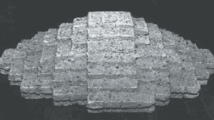Systematic analysis of the state and prospects of the development of additive technologies for computer-aided production is conducted to show a new paradigm of their evolution. An approach determining the additive methods as synergy technologies that provide self-organization of surface phenomena is suggested. The new approach is used for choosing the most efficient energy sources and materials for the technologies of layer-by-layer synthesis of articles. It is shown that stabilization of the thickness of the formed layers correlates with the processes of self-organization of surface phenomena and design features of the articles.
Similar content being viewed by others
References
I. Gibson, D. Rosen, and B. Stuker, Additive Manufacturing Technologies: 3D Printing, Rapid Prototyping, and Direct Digital Manufacturing, Springer, New York (2015).
F. Froes and R. Boyer (eds.), Additive Manufacturing for the Aerospace Industry, Elsevier, Cambridge (2019).
A. I. Rudskoy, S. Yu. Kondrat’ev, and Yu. A. Sokolov, “New approach to synthesis of powder and composite materials by electron beam. Part 1. Technological features of the process,” Met. Sci. Heat Treat., 58(1–2), 27 – 32 (2016).
M. L. Kheifets, L. M. Kozhuro, and Zh. A. Mrochek, Processes of Self-Organization during the Formation of Surfaces [in Russian], IMMS NANB, Gomel (1999).
A. I. Gordienko, M. L. Kheifetz, L. M. Kozhouro, et al., Combined Physico-Chemical Treatment: Synergetic Aspect, Technoprint, Minsk (2004).
P. A. Vitiaz, M. L. Kheifetz, and S. V. Koukhta, Laser-Plasma Techniques in Computer-Controlled Manufacturing, Belorusskaya Nauka, Minsk (2011).
A. I. Rudskoy, K. N. Volkov, S. Yu. Kondrat’ev, and Yu. A. Sokolov, Physical Processes and Technologies for Producing Metal Powders from Melt [in Russian], Izd-vo Politekhnicheskogo Universiteta, St. Petersburg (2018).
A. I. Rudskoi, S. Yu. Kondrat’ev, Yu. A. Sokolov, and V. N. Kopaev, “Simulation of the layer-by-layer synthesis of articles with an electron beam,” Tech. Phys., 60(11), 1663 – 1669 (2015).
M. L. Kheifets, Formation of the Materials Properties in the Layer-by-Layer Synthesis of Articles [in Russian], PGU, Novopolotsk (2001).
A. M. Rusetskii (ed.), Theoretical Foundations of Technological Complexes Design [in Russian], Belorusskaya Nauka, Minsk (2012).
V. N. Poduraev, Technology of Physical-Chemical Processing Methods [in Russian], Mashinostroenie, Moscow (1985).
B. I. Kostetskii, I. G. Nosovskii, L. I. Bershadskii, and A. K. Karaulov, Reliability and Durability of Machines [in Russian], Tekhnika, Kiev (1975).
M. L. Kheifets, Design Processes of Combined Processing [in Russian], Mashinostroenie, Moscow (2005).
O. P. Golubev, S. V. Kuchta, Zh. A. Mrochek, et al., Advanced Technologies of Machinery Production [in Russian], PGU, Novopolotsk (2007).
Zh. I. Alferov, “The history and future of semiconductor heterostructures,” Fiz. Tekhn. Poluprovodn., 32(3), 2 – 7 (1998).
M. L. Kheifets, “Additive synergy technologies of the layer-by-layer synthesis of articles from composite materials under the energy flow exposure,” Naukoemk. Tekhnol. Mashinostr., No. 4(58), 3 – 9 (2016).
P. A. Vityaz, M. L. Kheifets, and S. A. Chizhik, “Industry 4.0: from information and communication and additive technologies to self-reproduction of machines and organisms,” Izv. Nats. Akad. Nauk Belarusi, Ser. Fiz.-Tekhn. Nauk, No. 2, 54 – 72 (2017).
N. N. Dorozhkin, V. A. Mironov, V. A. Vereshchagin, and A. A. Kot, Electrophysical Methods for Producing Coatings from Metal Powders [in Russian], Zinatne, Riga (1985).
V. N. Tkachev, B. M. Fishtein, N. V. Kazintsev, and D. A. Aldyrev, Induction Surfacing of Hard Alloys [in Russian], Mashinostroenie, Moscow (1970).
P. A. Vityaz, V. S. Ivashko, and E. D. Manoilo, Theory and Practice of Flame Spraying [in Russian], Navuka i Tekhnika, Minsk (1993).
M. L. Kheifets, L. M. Akulovich, Zh. A. Mrochek, and E. Z. Zeveleva, Electrophysical and Electrochemical Methods of Materials Processing [in Russian], PGU, Novopolotsk (2012).
E. D. Eidelman, “Excitation of electric instability by heating,” Usp. Fiz. Nauk, 165(11), 1279 – 1294 (1995).
L. G. Loytsyansky, Mechanics of Liquids and Gases [in Russian], Nauka, Moscow (1987).
Author information
Authors and Affiliations
Corresponding author
Additional information
Translated from Metallovedenie i Termicheskaya Obrabotka Metallov, No. 1, pp. 11 – 18, January, 2020.
Rights and permissions
About this article
Cite this article
Chizhik, S.A., Vityaz, P.A. & Kheifets, M.L. Additive Synergy Technologies of Formation of Surface Layer of a Complex-Profile Article. Met Sci Heat Treat 62, 11–17 (2020). https://doi.org/10.1007/s11041-020-00506-3
Published:
Issue Date:
DOI: https://doi.org/10.1007/s11041-020-00506-3




